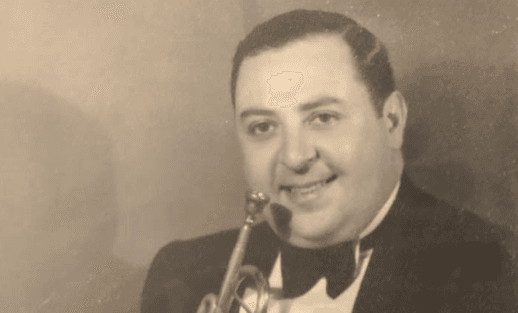1920s Trumpet Star’s Granddaughter Talks To The Phantom Dancer

1920s jazz trumpet star, Bob Effros, whose trumpet you’ve heard on Betty Boop & Popeye cartoons, is this week’s Phantom Dancer feature artist.
His granddaughter, Barbara Effros is writing a book about this 1920s jazz trumpet great. She spoke to Phantom Dancer Greg Poppleton about her grandfather whose trumpet you’ve heard probably hundreds of times without knowing.
“Barbara, on my LP copy of the cardboard ‘Hit of the Week’ record, ‘If I Could Be With You One Hour Tonight’, the liner notes query whether the trumpet solo is by Bob Effros or Red Nichols? Who is playing?”
Barbara wrote back,
“Hi Greg, yes indeed. This is my Grandpa Bob Effros with Dick Robertson on vocals. He recorded over 50 sides on HOW Discs including songs with Rudy Vallee , Eddie Cantor and others. Am building the HOW discography. Grandpa recorded over 200 recordings and composed 13 songs. ‘Tin Ear’, ‘Corn Fed’ and ‘Why Don’t You Get Lost’ are most popular from the 1920s. In 1942 he composed ‘Memr’y of this Dance’ with Ben Selvin. Also ‘A Million Reasons to Smile’ with Al Sherman recorded by Abe Lyman.”

Barbara wrote a short biography of Bob Effros published in The Syncopated Times, 1 January 2017 https://syncopatedtimes.
She writes that Bob was born in London in 1900 and moved with his parents to Memphis when very young. He ran away from home at 11 and worked on the riverboats where he heard jazz and picked up the cornet, listening to Joe ‘King’ Oliver. From 1917-19 he was a bugler in the US Army.
“After the war ended, he settled down in Baltimore playing in a band led by dancer and vocalist Bee Palmer. When Bob Effros arrived in New York, his only friend was from Memphis: W.C. Handy, ‘Father of The Blues.’ Mr. Handy sent to the young trumpeter to Sam Lanin for his first gig, and was hired at the Roseland Ballroom.”
1920s
Bob was an in demand trumpeter on the New York scene. He was in the Vincent Lopez Orchestra from 1921-27 and by 1929 was leading his own orchestra.
In the meantime he toured Europe frequently with Lopez with whom he remained a life-long friend.
Famous singers on whose recordings he played in the 20s include Annette Hanshaw, Bessie Smith, the Boswell Sisters, Libby Holman, Ruth Etting, Ethel Waters, Mae Questal and Fanny Brice.
He played with Benny Goodman, Fletcher Henderson, Sam Lanin, Vincent Lopez, Red Nichols, Harry Reser and Ben Selvin.
He made over 200 recordings with such famous sidemen as Jimmy and Tommy Dorsey, Cab Calloway, Xavier Cugat, Al Jolson, Eddie Lang, Joe Venuti, Jimmy Durante, Washboard Sam, W.C. Handy, Scrappy Lambert, Red Nichols, and Fats Waller.
Paul Whiteman chose him to fill in for the legendary trumpeter Bix Beiderbecke.
COMPOSER
Bob wrote over a dozen hit songs including ‘Why The Twenties Roared,’ ‘Tin Ear’ (this week’s Phantom Dancer video), ‘Cornfed’, and ‘Why Don’t You Get Lost?’. ‘Sweet and Hot’ was his ode to Chinese soup.

1930s AND BEYOND
According to German wiki, in 1929, Bob started a family and got steady employment as a sudio musician for Vitaphone, recording music for the Betty Boop, Popeye and Feliz the Cat cartoons.
On 27 August 1929 he recorded, under his own name for Brunswick (#4620), his own compositions ‘Tin Ear’ (this recording is this week’s video, below) and ‘Sweet and Hot’.
Bob remained active in the studios into the 1940s.
Barbara writes, “[He also] Spent a couple years in Los Angeles with Max Roach Studios recording for Little Rascals Shows, Buster Keaton, Marx Brothers, and more.” So, that means you’ll hear Bob on those great Little Rascals and Laurel and Hardy soundtracks.
Barbara Effros is now writing a book about her jazz trumpeter grandfather.
Barbara wrote to me about where the book is at right now, “Still working on book – it’s a labor of love. I’ve become immersed in jazz history, personalities, Black/White cultural issues in USA/UK. I’ve yet to fully research Grandpa’s performances in Australia and South America. I have passports, ship manifestos galore. Perhaps you can direct me regrading Australian music magazines of the 1930s and 40s?”
If you have any info, please contact Barbara,
